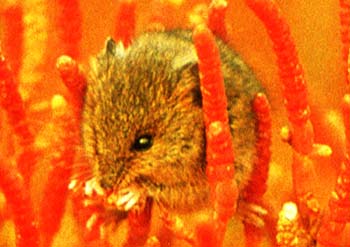![[Metroactive News&Issues]](/gifs/news468.gif)
[ San Jose | Metroactive Central | Archives ]
 Photograph by George Sakkestad Mouse Pad The salt marsh harvest mouse holds onto its habitat for dear life By Jim Rendon Name: Reithrodontomys raviventris Status: Endangered Natural Habitat: San Francisco Bay Last Stand: San Francisco Bay Wildlife Refuge Reason for Demise: San Jose water pollution control plant WHERE SAN JOSE MEETS the bay, a rippling waterway is marked by head-high bulrushes bending in the breeze. These towering green grasses stick up in stark contrast to the low green tangle of plants in the surrounding marsh, like a spiked mohawk rising off an otherwise shaved head. The waterway flows not from any river but from San Jose's sewage treatment plant, which pumps more than 120 million gallons a day of treated water into San Francisco Bay. As the water makes its way through the salt marsh, it dilutes the marsh's salt content. This completely changes the marsh ecology, turning the salt water brackish, causing some plants and animals to die off and others to thrive. Few of the creatures in the nearby bog can survive here, including the endangered salt marsh harvest mouse. "The mouse does not have a great ability to move far if its habitat is disturbed," says Joy Albertson. Small, localized dieouts are common among the species. The freshwater intrusion kills off pickleweed, a thick-stemmed marsh plant that occurs only in the healthiest salt marsh. The mouse is almost totally dependent on pickleweed. The plant provides the mouse with most of its food and is a great source of shelter. In order to hide from hawks, egrets, herons and other predators, the mice stay obscured beneath the thick plants. And if all else fails when the tide comes in, the mouse can cling to the sturdy plant until the water is sucked back out into the bay. The mouse can also swim and float if need be. And it is one of the only mammals that drinks salt water. Though a subspecies of the mouse can be found in the North Bay, the salt marsh harvest mouse is found nowhere but in the marshes of the South Bay. Since the mice mostly come out at night and remain hidden in the day, no one knows how many mice exist. But as their habitat gets fragmented and overrun with non-native predators, they have become vulnerable to extinction. As with the clapper rail, any major disturbance of the few thousand remaining acres of marsh could quite easily make the mouse a has-been. [ San Jose | Metroactive Central | Archives ]
|
From the November 24-December 1, 1999 issue of Metro, Silicon Valley's Weekly Newspaper.
Copyright © 1999 Metro Publishing Inc. Metroactive is affiliated with the Boulevards Network.
For more information about the San Jose/Silicon Valley area, visit sanjose.com.